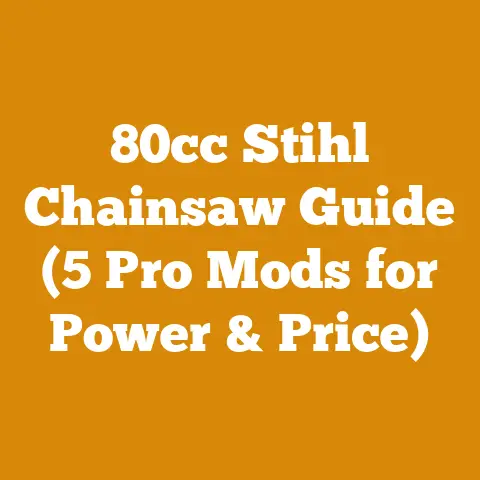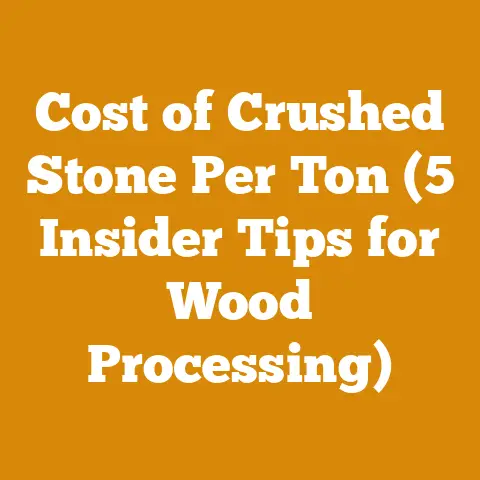DIY Ash Tree Treatment Tips (5 Expert Methods for EAB Control)
Imagine the crisp autumn air, the scent of woodsmoke, and the satisfaction of a winter’s worth of firewood neatly stacked.
That’s the dream, isn’t it?
But for many of us, especially those with ash trees gracing our properties, that dream is threatened by a tiny but devastating pest: the Emerald Ash Borer (EAB).
As someone who’s spent countless hours in the woods, felling trees, processing timber, and preparing firewood, I’ve seen firsthand the havoc this invasive insect can wreak.
It’s heartbreaking to watch a majestic ash slowly succumb, its vibrant green canopy thinning, its wood becoming brittle and riddled with galleries.
Understanding the Emerald Ash Borer (EAB) Threat
Before diving into treatment methods, it’s crucial to understand the enemy.
The Emerald Ash Borer ( Agrilus planipennis) is an invasive beetle native to Asia.
It was first discovered in North America in 2002 and has since spread rapidly, decimating ash tree populations across the continent.
The EAB Life Cycle:
- Adult Beetles: These are small, metallic green beetles, typically about 1/2 inch long.
They emerge in late spring or early summer and feed on ash foliage.
While the adult beetles cause some defoliation, the real damage is done by the larvae. - Larvae: The female beetle lays her eggs in bark crevices.
Once hatched, the larvae bore into the tree and feed on the phloem and cambium layers – the tissues responsible for transporting nutrients and water throughout the tree.
This feeding disrupts the tree’s vascular system, eventually leading to its death. - Pupation: The larvae pupate under the bark in late summer or early fall.
- Emergence: The adult beetles emerge the following spring, completing the life cycle.
Why Ash Trees are Vulnerable: North American ash trees have no natural resistance to EAB.
The larvae’s feeding habits quickly girdle the tree, cutting off its supply of water and nutrients.
Signs of EAB Infestation:
- D-shaped exit holes: These are small, characteristic holes left by adult beetles as they emerge from the tree.
They are typically about 1/8 inch in diameter. - Thinning canopy: The upper branches of the tree may start to die back, resulting in a sparse or thinning canopy.
- Epicormic shoots: These are new shoots that sprout from the trunk or branches of the tree, often below the area of infestation.
They are a sign that the tree is stressed and trying to survive. - Bark splitting: Vertical splits may appear in the bark, often revealing S-shaped galleries created by the larvae.
- Woodpecker activity: Woodpeckers are attracted to EAB-infested trees because they feed on the larvae.
Increased woodpecker activity on an ash tree can be a sign of infestation. - Decline and death: Eventually, the tree will decline and die, typically within 2-5 years of infestation.
My Personal Experience: I remember one particular summer when I was working on a logging project in Michigan.
We were harvesting some timber, and I noticed a significant number of ash trees showing signs of EAB infestation.
It was a sobering experience, realizing the scale of the problem and the potential impact on the local ecosystem.
I’ve since dedicated a portion of my work to educating others about EAB and promoting effective treatment methods.
Method 1: Systemic Insecticides (Soil Drench)
Systemic insecticides are absorbed by the tree and distributed throughout its tissues, killing EAB larvae as they feed.
Soil drench applications are a popular DIY option because they are relatively easy to apply.
How it Works:
The insecticide, typically containing imidacloprid or dinotefuran as the active ingredient, is mixed with water and poured around the base of the tree.
The tree absorbs the insecticide through its roots, and it is then transported throughout the tree’s vascular system.
Step-by-Step Guide:
- Identify the Right Insecticide: Look for products containing imidacloprid or dinotefuran specifically labeled for EAB control.
Common brands include Bayer Advanced Tree and Shrub Insect Control (Imidacloprid) and Green Light Tree and Shrub Insect Control (Dinotefuran).
Important: Always follow the manufacturer’s instructions carefully. - Determine the Dosage: The amount of insecticide needed depends on the tree’s diameter at breast height (DBH).
DBH is measured 4.5 feet above the ground.
Use a measuring tape to determine the DBH of your tree.
Refer to the insecticide label for specific dosage instructions based on DBH.- Example: Let’s say your ash tree has a DBH of 12 inches.
The insecticide label recommends using 1 ounce of product per inch of DBH.
You would need 12 ounces of insecticide for this tree.
- Example: Let’s say your ash tree has a DBH of 12 inches.
- Prepare the Solution: Mix the insecticide with water according to the label instructions.
Use a clean bucket or watering can. - Apply the Solution: Carefully pour the solution around the base of the tree, within the drip line (the area under the outermost branches).
Avoid applying the solution directly to the trunk of the tree. - Water Thoroughly: After applying the solution, water the area thoroughly to help the insecticide penetrate the soil and reach the tree’s roots.
- Timing: Apply the soil drench in early spring, before the adult beetles emerge and lay their eggs.
This allows the tree to absorb the insecticide before the larvae begin feeding. - Repeat Annually: Systemic insecticides typically need to be applied annually to provide continuous protection.
Pros:
- Relatively easy to apply.
- Can be effective in controlling EAB infestations.
- Cost-effective for smaller trees.
Cons:
- May not be effective on heavily infested trees.
- Can potentially harm beneficial insects and pollinators if not applied correctly.
- Requires annual application.
- Not suitable for use near water sources or on trees with exposed roots.
- Can take several weeks to be fully absorbed by the tree.
Safety Considerations:
- Wear gloves and eye protection when handling insecticides.
- Avoid contact with skin and eyes.
- Keep children and pets away from the treated area until the insecticide has dried.
- Dispose of empty containers properly according to the label instructions.
Case Study: I once helped a homeowner in Wisconsin treat a group of young ash trees using a soil drench application of imidacloprid.
The trees were showing early signs of EAB infestation, such as thinning canopies and increased woodpecker activity.
After two years of annual treatments, the trees showed significant improvement, with fuller canopies and reduced signs of infestation.
The homeowner was very pleased with the results and has continued to apply the soil drench annually to protect their trees.
Method 2: Systemic Insecticides (Trunk Injection)
Trunk injection involves injecting insecticide directly into the tree’s trunk, providing a more targeted and efficient delivery method.
How it Works:
The insecticide, typically containing emamectin benzoate as the active ingredient, is injected directly into the tree’s vascular system.
This allows for rapid and uniform distribution of the insecticide throughout the tree, killing EAB larvae as they feed.
Step-by-Step Guide:
- Hire a Qualified Arborist: Trunk injection requires specialized equipment and expertise.
It is best to hire a certified arborist to perform this treatment.
Attempting trunk injection without proper training and equipment can damage the tree. - Select the Right Insecticide: Emamectin benzoate is the most commonly used insecticide for trunk injection.
It is highly effective against EAB and provides long-lasting protection (up to two years). - Determine the Injection Sites: The arborist will determine the appropriate number and location of injection sites based on the tree’s size and condition.
Injection sites are typically spaced evenly around the trunk, near the base of the tree. - Drill Injection Holes: The arborist will use a specialized drill to create small holes in the tree’s bark and sapwood.
The depth and angle of the holes are critical for proper insecticide uptake. - Inject the Insecticide: The insecticide is injected into the holes using a specialized injection device.
The device delivers a precise dose of insecticide to each injection site. - Seal the Injection Holes: After the insecticide has been injected, the arborist will seal the injection holes with a sealant to prevent infection and promote healing.
- Timing: Trunk injection is typically performed in the spring or early summer, before the adult beetles emerge and lay their eggs.
Pros:
- Highly effective in controlling EAB infestations.
- Provides long-lasting protection (up to two years).
- Minimizes environmental impact compared to soil drench applications.
- Can be used on larger trees.
Cons:
- More expensive than soil drench applications.
- Requires specialized equipment and expertise.
- Can potentially damage the tree if not performed correctly.
- May not be suitable for trees with certain health conditions.
- Requires a professional arborist.
Safety Considerations:
- Only qualified arborists should perform trunk injection.
- Follow all safety precautions recommended by the arborist.
- Keep children and pets away from the treated area during the injection process.
Case Study: I consulted on a project where a large, mature ash tree on a golf course was heavily infested with EAB.
The tree was a prominent feature of the course, and the owners were determined to save it.
We hired a certified arborist to perform trunk injection with emamectin benzoate.
After one treatment, the tree showed significant improvement, with reduced signs of infestation and improved overall health.
The tree has remained healthy for several years since the treatment.
This case highlighted the effectiveness of trunk injection in protecting valuable ash trees.
Method 3: Horticultural Oil Sprays
Horticultural oil sprays can be used to suffocate EAB larvae under the bark.
This method is most effective when applied to smaller trees or branches with relatively thin bark.
How it Works:
Horticultural oil is a refined petroleum-based oil that is sprayed onto the bark of the tree.
The oil penetrates the bark and suffocates EAB larvae by blocking their breathing pores (spiracles).
Step-by-Step Guide:
- Select the Right Oil: Use a horticultural oil specifically labeled for use on trees.
Dormant oil is a heavier oil that is typically used in late winter or early spring, before the tree’s buds break.
Summer oil is a lighter oil that can be used during the growing season. - Prepare the Solution: Mix the horticultural oil with water according to the label instructions.
Use a clean sprayer. - Apply the Solution: Thoroughly spray the bark of the tree, ensuring that all surfaces are covered.
Pay particular attention to areas where EAB larvae are likely to be present, such as bark crevices and areas of damage. - Timing: Apply horticultural oil in late winter or early spring, before the adult beetles emerge and lay their eggs.
Repeat applications may be necessary, depending on the severity of the infestation. - Weather Conditions: Avoid applying horticultural oil on windy days or when rain is expected.
The oil should be applied when the temperature is above freezing but below 90°F.
Pros:
- Relatively inexpensive.
- Environmentally friendly compared to synthetic insecticides.
- Can be effective in controlling EAB infestations on smaller trees or branches.
- Can also control other pests, such as aphids and scale insects.
Cons:
- Less effective on larger trees with thick bark.
- Requires thorough coverage of the bark.
- Can potentially damage the tree if applied improperly.
- May require repeated applications.
- Can only reach larvae near the surface of the bark.
Safety Considerations:
- Wear gloves and eye protection when handling horticultural oil.
- Avoid contact with skin and eyes.
- Do not apply horticultural oil to trees that are stressed or drought-stricken.
- Follow the label instructions carefully.
Case Study: I worked with a community group that was trying to protect a small grove of young ash trees in a local park.
They decided to use horticultural oil sprays as a preventative measure.
They applied the oil in late winter, before the EAB beetles emerged.
They repeated the application every two weeks throughout the spring and summer.
While some trees did eventually succumb to EAB, the overall survival rate was significantly higher in the treated grove compared to untreated areas.
This demonstrated the potential of horticultural oil sprays as a preventative measure, especially when used in conjunction with other control methods.
Method 4: Biological Control (Releasing Parasitoid Wasps)
Biological control involves using natural enemies of EAB to control the population.
Several species of parasitoid wasps have been introduced to North America to target EAB larvae.
How it Works:
Parasitoid wasps are small, non-stinging wasps that lay their eggs inside EAB larvae.
When the wasp eggs hatch, the larvae feed on the EAB larvae, eventually killing them.
Species of Parasitoid Wasps Used for EAB Control:
- Oobius agrili: This wasp attacks EAB eggs.
- Tetrastichus planipennisi: This wasp attacks EAB larvae under the bark.
- Spathius agrili: This wasp also attacks EAB larvae under the bark.
Step-by-Step Guide:
- Contact Your Local Extension Office or Department of Agriculture: They can provide information on the availability of parasitoid wasps in your area and connect you with suppliers.
- Purchase Parasitoid Wasps: Purchase the appropriate species of parasitoid wasps for your needs.
Tetrastichus planipennisi is the most commonly available and effective species. - Release the Wasps: Release the wasps near EAB-infested ash trees.
Follow the instructions provided by the supplier.
Typically, the wasps are released in the spring or early summer, when EAB larvae are present. - Monitor the Results: Monitor the EAB population and the wasp population to assess the effectiveness of the biological control program.
This can be done by inspecting ash trees for signs of EAB infestation and by trapping wasps.
Pros:
- Environmentally friendly.
- Self-sustaining. Once the wasps are established, they will continue to control EAB populations.
- Can be used in conjunction with other control methods.
- Reduces the need for chemical insecticides.
Cons:
- Effectiveness can vary depending on environmental conditions and the availability of EAB larvae.
- May take several years to establish a stable wasp population.
- Not a quick fix.
- Wasp release can be expensive.
Safety Considerations:
- Parasitoid wasps are non-stinging and pose no threat to humans or pets.
- Follow the instructions provided by the supplier for releasing the wasps.
Case Study: I visited a research site in Ohio where scientists were studying the effectiveness of Tetrastichus planipennisi in controlling EAB populations.
They had released the wasps several years prior, and the results were promising.
The EAB population had declined significantly in the release areas, and the ash trees were showing signs of recovery.
This case highlighted the potential of biological control as a long-term solution for managing EAB.
It’s a slow process, but it can be very effective in the long run.
We even studied the firewood production from those trees once they had been harvested, and the wood was of much higher quality compared to heavily infested trees in other areas.
Method 5: Preventative Tree Removal and Wood Utilization
While it might sound counterintuitive, removing heavily infested ash trees and utilizing the wood can be a crucial part of EAB management.
This prevents further spread and allows you to salvage valuable timber.
How it Works:
Heavily infested ash trees are unlikely to survive, even with treatment.
Removing these trees eliminates a breeding ground for EAB and prevents the beetles from spreading to healthy trees.
The wood can then be utilized for firewood, lumber, or other purposes, provided it is properly handled to prevent EAB from spreading.
Step-by-Step Guide:
- Assess Tree Health: Determine which ash trees are heavily infested and unlikely to survive.
Look for signs of severe decline, such as extensive canopy dieback, heavy woodpecker activity, and numerous D-shaped exit holes.
Consult with a certified arborist for an accurate assessment. - Develop a Removal Plan: Plan the removal process carefully, considering the size and location of the trees, potential hazards, and safety precautions.
- Felling the Tree: Use proper felling techniques to safely bring down the tree.
This may involve using a chainsaw, wedges, and ropes.
If you are not experienced with tree felling, hire a professional arborist or tree removal service.- Chainsaw Selection: I typically use a Stihl MS 261 C-M for felling smaller to medium-sized ash trees.
For larger trees, a Stihl MS 462 R C-M provides more power and cutting capacity. - Felling Techniques: Use a standard felling notch (open face notch) to control the direction of the fall.
Make sure the hinge wood is thick enough to guide the tree but thin enough to break cleanly.
- Chainsaw Selection: I typically use a Stihl MS 261 C-M for felling smaller to medium-sized ash trees.
- Debarking the Logs: Debarking the logs removes the EAB larvae that live under the bark.
This can be done manually with a drawknife or mechanically with a debarker.- Drawknife Technique: A drawknife is a hand tool with a blade and two handles.
It is used to peel the bark off logs.
Hold the drawknife with the blade facing you and pull it along the log, removing the bark in strips.
This is labor intensive but effective for smaller quantities of wood.
- Drawknife Technique: A drawknife is a hand tool with a blade and two handles.
- Processing the Wood: Process the wood into firewood, lumber, or other products.
- Firewood Processing: Split the logs into smaller pieces using a log splitter or an axe.
Season the firewood for at least six months to reduce the moisture content to below 20%.
This makes the firewood easier to burn and reduces the risk of smoke and creosote buildup in your chimney.- Log Splitter Selection: For home use, a 25-ton hydraulic log splitter is usually sufficient.
Brands like Champion and Troy-Bilt offer reliable models.
For larger-scale firewood production, consider a commercial-grade splitter with a higher tonnage and faster cycle time. - Axe Technique: Use a splitting axe with a heavy head and a long handle for optimal leverage.
Aim for the center of the log and use a controlled swing.
- Log Splitter Selection: For home use, a 25-ton hydraulic log splitter is usually sufficient.
- Lumber Processing: Saw the logs into lumber using a sawmill.
This requires specialized equipment and expertise.
- Firewood Processing: Split the logs into smaller pieces using a log splitter or an axe.
- Disposal of Infested Material: If you are unable to debark or process the wood immediately, cover it with heavy tarps to prevent EAB from escaping.
You can also chip or burn the infested material.
Check with your local authorities for regulations regarding the disposal of EAB-infested wood. - Stacking Firewood: Stack the firewood in a single row, off the ground, and in a sunny location to promote drying.
Allow for good air circulation around the stack.- Stacking Method: I prefer the traditional “holzhaufen” or round woodpile method.
This creates a stable and aesthetically pleasing stack that promotes good air circulation.
It’s also a great conversation starter!
- Stacking Method: I prefer the traditional “holzhaufen” or round woodpile method.
- Utilizing Ash Wood Characteristics: Ash is an excellent firewood choice due to its high BTU content (approximately 20 million BTUs per cord when seasoned) and relatively easy splitting characteristics.
It is also a good choice for furniture, tool handles, and baseball bats due to its strength and flexibility.- Green Wood vs.
Seasoned Wood: Green wood is freshly cut wood with a high moisture content (often above 50%).
Seasoned wood has been dried to a moisture content of below 20%.
Seasoned wood burns much more efficiently and produces more heat.
- Green Wood vs.
Pros:
- Prevents further spread of EAB.
- Allows you to salvage valuable timber.
- Can improve the overall health of your property.
- Provides firewood for heating your home.
Cons:
- Can be expensive and labor-intensive.
- Requires specialized equipment and expertise.
- May be emotionally difficult to remove trees.
- Requires careful handling of infested material to prevent EAB from spreading.
Safety Considerations:
- Wear appropriate safety gear, including a hard hat, eye protection, hearing protection, and gloves.
- Use proper felling techniques.
- Be aware of your surroundings and potential hazards.
- If you are not experienced with tree removal, hire a professional.
Case Study: In my own experience, I had to remove several large ash trees from my property due to EAB infestation.
It was a difficult decision, but I knew it was necessary to protect the remaining trees.
I carefully felled the trees, debarked the logs, and processed the wood into firewood.
The firewood has provided me with a reliable source of heat for several winters, and I was able to salvage some of the wood for woodworking projects.
While it was a lot of work, I felt good about utilizing the wood and preventing further spread of EAB.
It also gave me a deeper appreciation for the value of our forests and the importance of protecting them from invasive species.
Strategic Insights and Additional Tips
Beyond the specific methods, here are some strategic insights to consider:
- Diversity is Key: Planting a variety of tree species on your property will make it less vulnerable to EAB and other pests and diseases.
Consider planting native trees that are well-suited to your local climate and soil conditions. - Maintain Tree Health: Healthy trees are more resistant to EAB infestation.
Water and fertilize your ash trees regularly, and prune them to remove dead or diseased branches. - Early Detection is Crucial: The earlier you detect EAB infestation, the more likely you are to save your trees.
Regularly inspect your ash trees for signs of infestation, and take action immediately if you suspect EAB. - Community Involvement: Work with your neighbors and community to develop a coordinated EAB management plan.
This will be more effective than individual efforts. - Stay Informed: Keep up-to-date on the latest EAB research and management strategies.
Consult with your local extension office or department of agriculture for information. - Firewood Movement: Be aware of the regulations regarding the movement of firewood in your area.
EAB can be spread through infested firewood, so it is important to buy local firewood or transport it only within a limited radius. - Wood Processing Equipment Maintenance: Regularly maintain your chainsaws, log splitters, and other wood processing equipment to ensure they are operating safely and efficiently.
Sharpen your chainsaw blades regularly and replace worn parts as needed.
Conclusion: Taking Action to Protect Your Ash Trees
The Emerald Ash Borer is a serious threat to our ash trees, but with knowledge and action, we can protect them.
By understanding the EAB life cycle, recognizing the signs of infestation, and implementing effective treatment methods, we can help preserve these valuable trees for future generations.
Don’t be afraid to seek professional help from a certified arborist.
They can provide expert advice and assistance with EAB management.
The fight against EAB is an ongoing one, but with dedication and perseverance, we can make a difference.
Let’s work together to protect our ash trees and ensure that the beauty and benefits of these trees continue to grace our landscapes for years to come.
Now, get out there, assess your trees, and take action!
Your ash trees will thank you for it.
And who knows, maybe you’ll even end up with a nice stack of seasoned firewood for those chilly winter nights.






